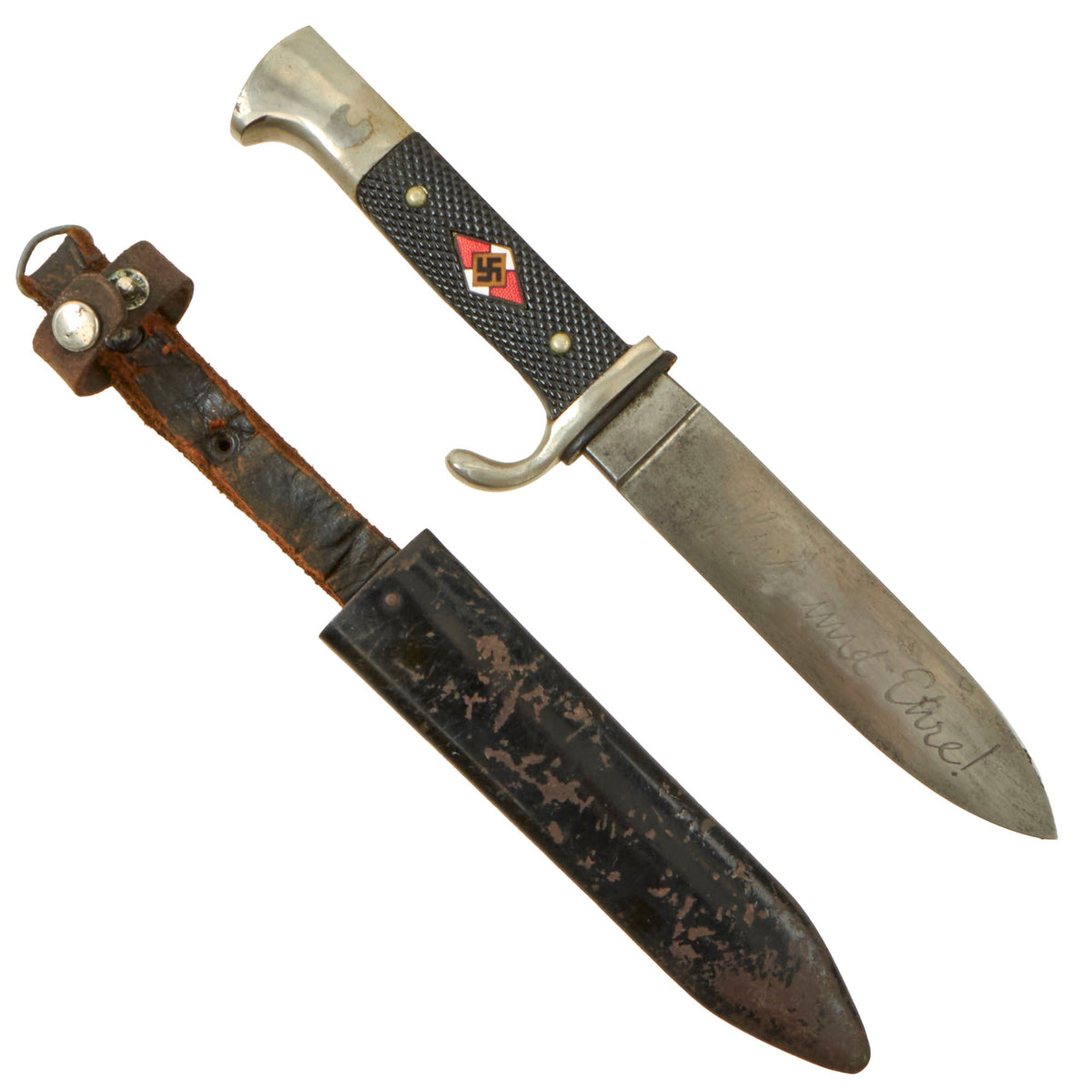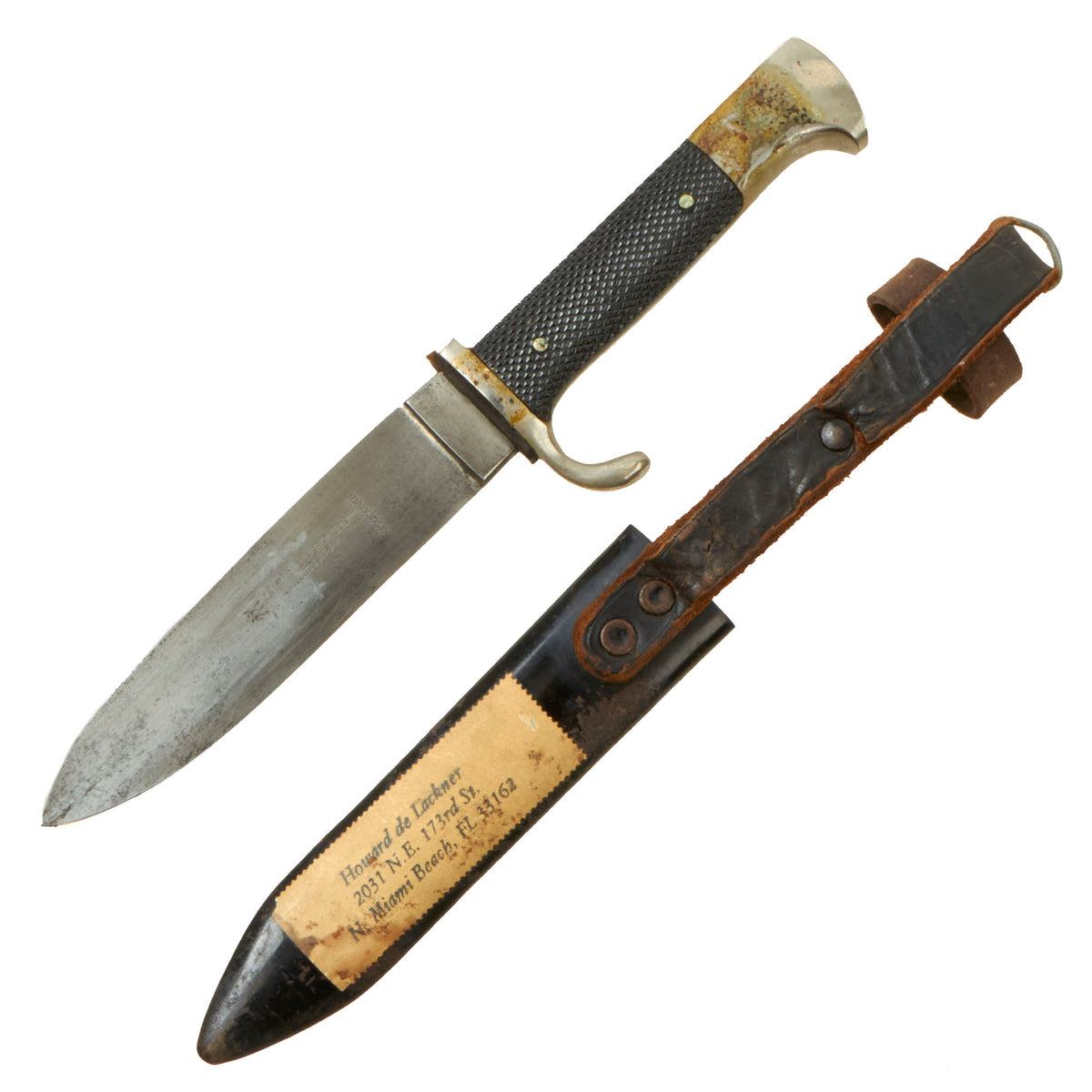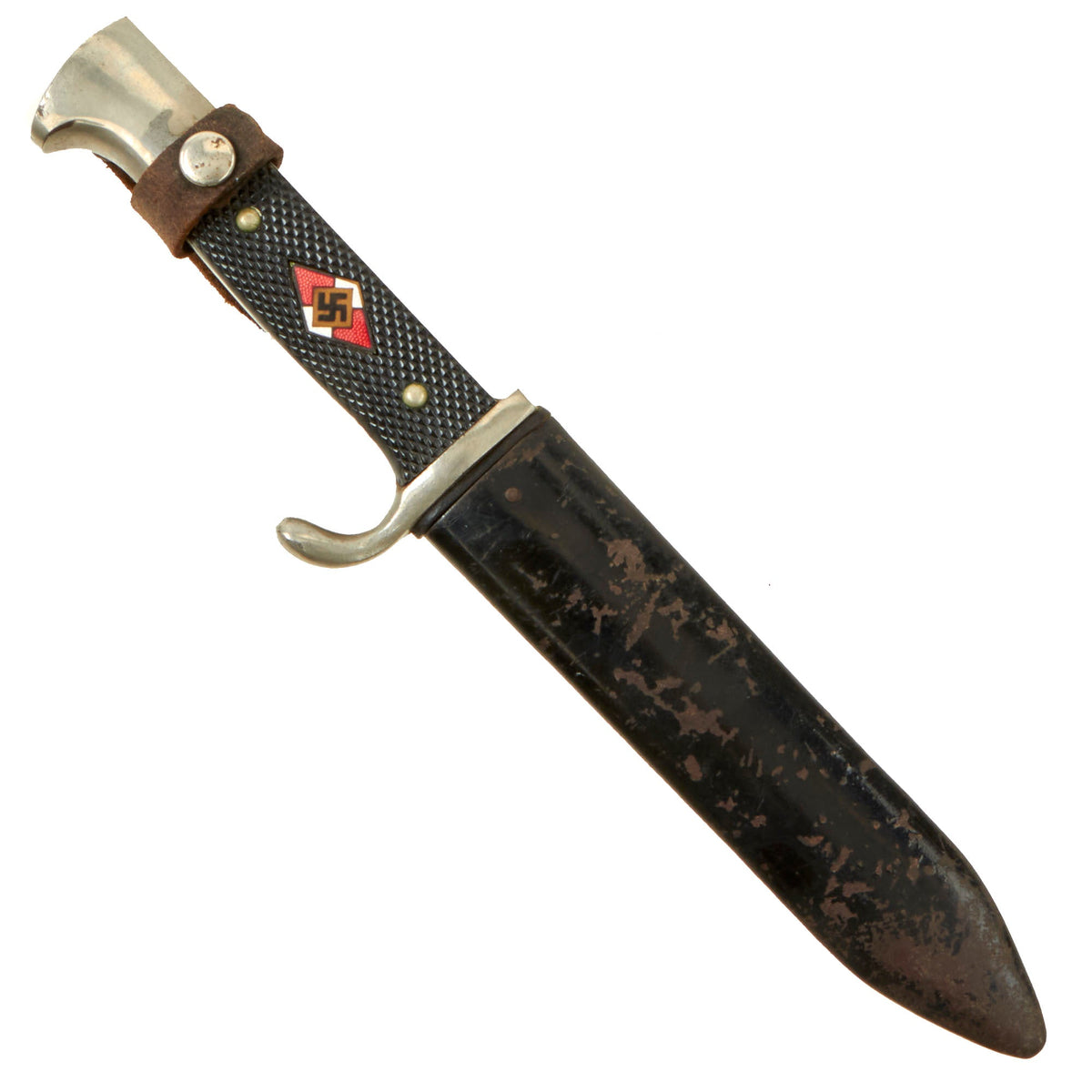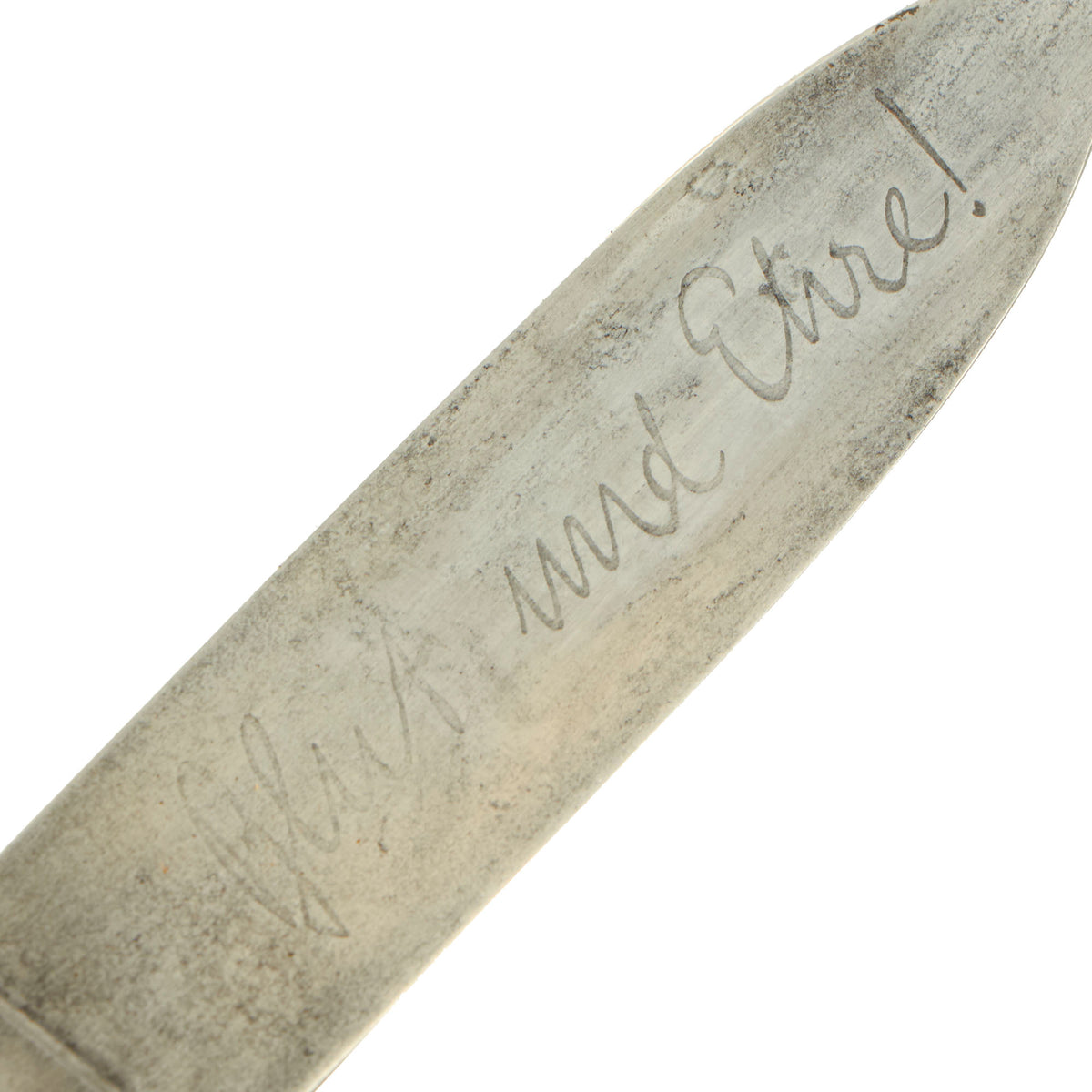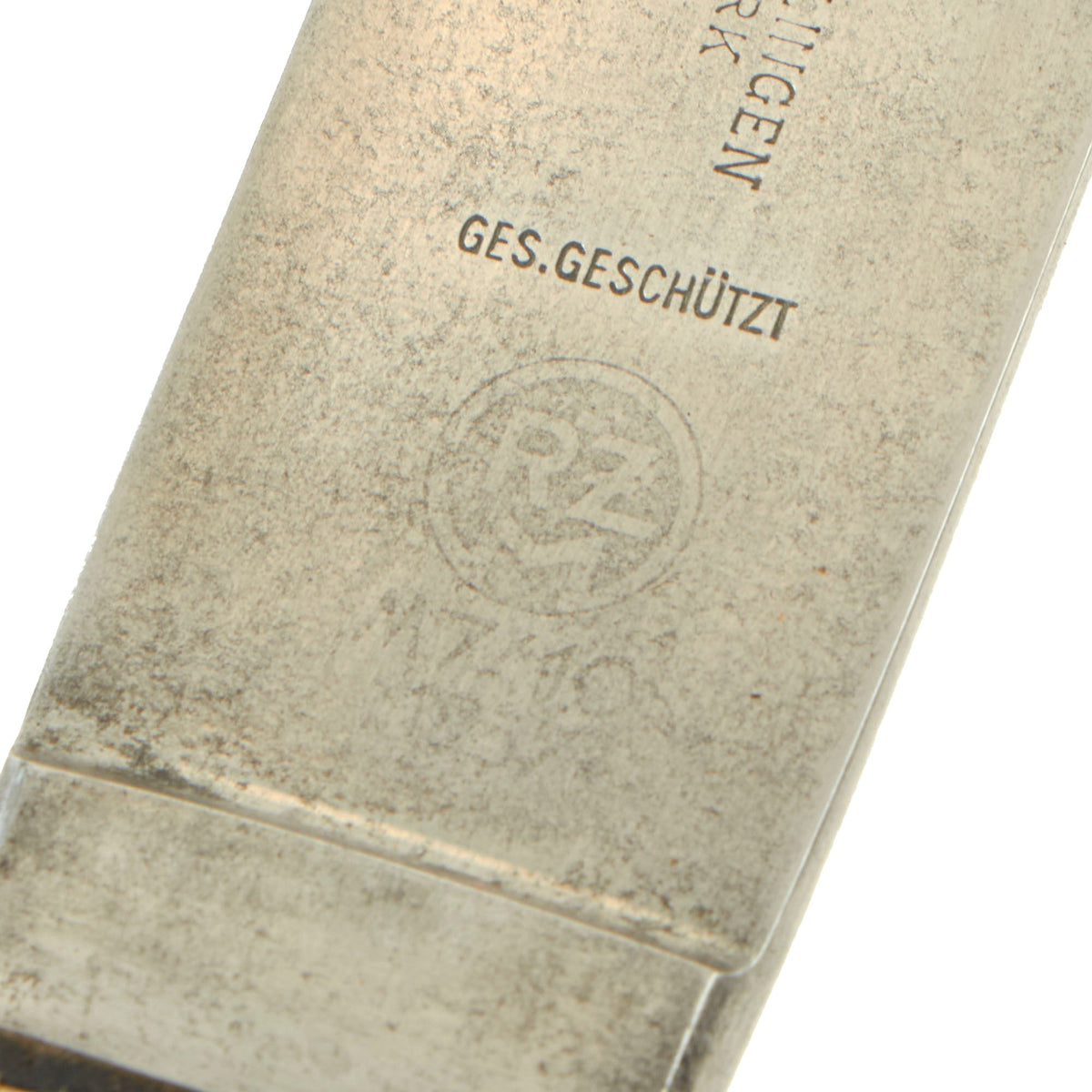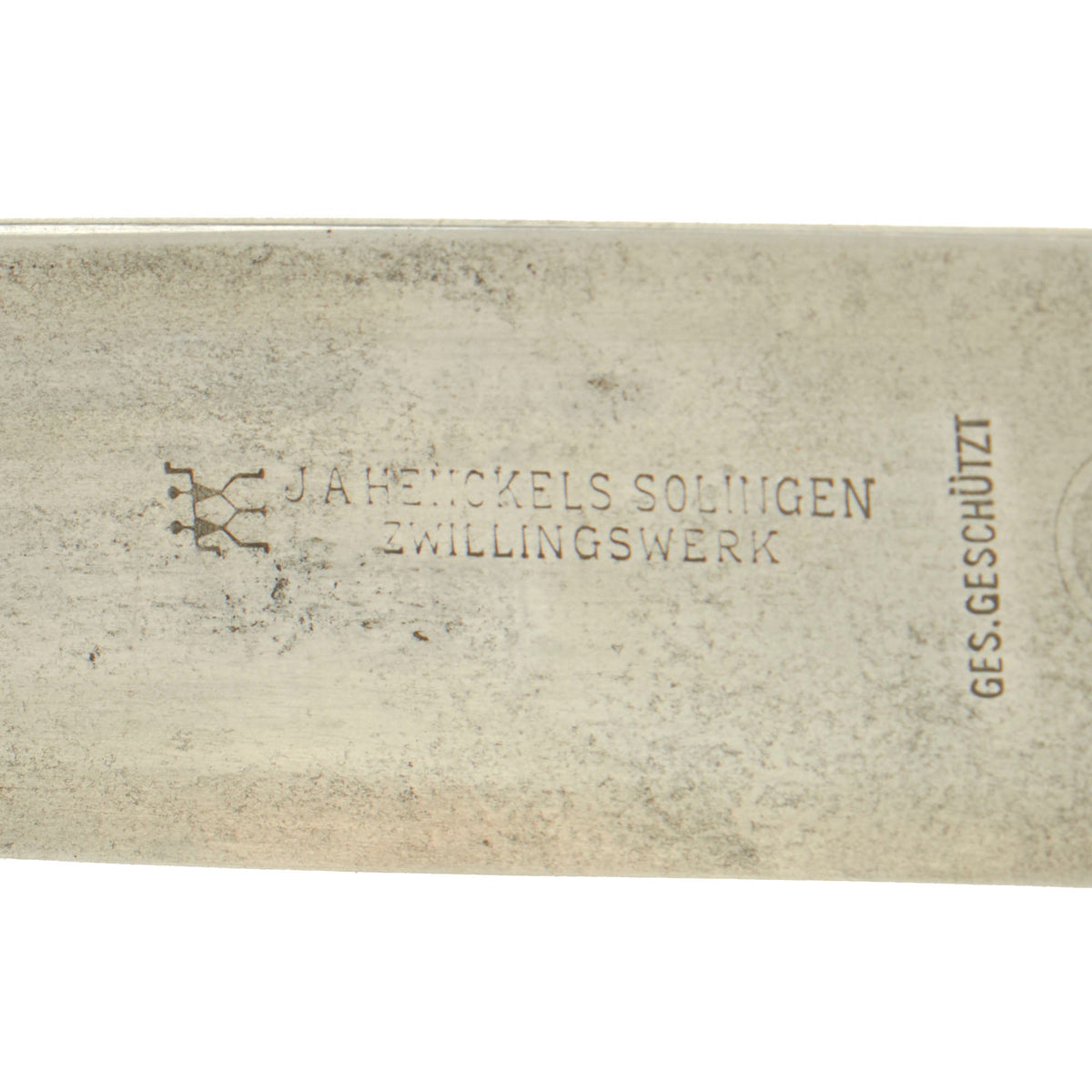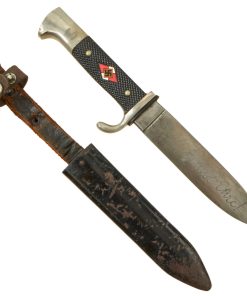Original German WWII 1937 Dated Transitional Motto Marked HJ Knife by J.A. Henckels with Scabbard – RZM M7/10 1937 Original Items
$ 850,00 $ 212,50
Original Item: Only One Available. This is a lovely service used condition transitional period HJ Fahrtenmesser (trip knife), marked on the blade by blade by the desirable maker J.A. Henckels Zwillingswerk of Solingen. This early HJ Knife is a very good example of the type, showing honest period wear, giving it a great “salty” patina. The plating on the steel hilt probably retained at about 75%, with wear from the securing strap, especially on the reverse, which shows some dried grease and oxidation.
The Bakelite grip plates are closely checkered and in very good condition, showing some light wear, and are retained by nickel rivets with dressed obverse heads. The HJ insignia is in good condition with the enamel nearly 100% intact, showing very little damage or wear. The plating is worn away leaving a lovely oxidized brass patina on the borders, with verdigris around the edges. The bakelite shrinks slightly over the years, which is why the emblem on this example is a bit loose, confirming authenticity.
The blade of this example is in very good condition, and is a very interesting example, probably made in 1937 during the changeover period to blades with a raised ricasso and RZM markings. It has the raised ricasso and the RZM code, however it also has the early pattern marker marking as well as the acid-etched motto Blut und Ehre! (Blood and Honor!) on the blade, though it is worn from use, oxidation, and subsequent cleaning.
The surface of the blade shows cleaning and polishing on both sides to remove dirt and oxidation, which has made the markings faint and also completely removed the original factory final polish grind crossgrain almost completely. This texture is iconic, and is the definitive identifying characteristic for a real WWII German Blade. It is only retained on the raised ricasso on this example. We can see that the blade definitely had oxidation staining and maybe surface rust on both sides, now cleaned away. The blade does not however appear to have been sharpened much or at all, and the shape is still correct. The original leather blade buffer is present on this example, but it does show wear and staining, as expected on a service used knife.
The reverse of the blade is maker marked with the “Twins” (Zwilling) trademark logo of J.A. Henckels AG, Zwillingswerk, Stahlwarenfabrik (“Twin Works” Steelware Factory) of Solingen, to the left of the company address:
J.A. HENCKELS. SOLINGEN
ZWILLINGSWERK
This well-known company has used the “Twins” trademark since it was founded June 13th, 1731 by Johann Peter Henckels as Die Zwillinge. The brand’s namesake was Johann Abraham Henckels the Elder (1771–1850), who renamed the brand after himself while under his leadership. The company registered several additional brands and trademarks over the years, including “triplets” and “quadruplets” to avoid confusion with their “twins” logo. The company was officially registered with Solingen in 1882, and became purveyors to the Prussian and Austrian imperial houses. They also began a healthy export business not long after.
During the third reich era, the company made SA and NSKK daggers, as well as forged blades for other manufacturers. They manufactured HJ knives, but they seem to be somewhat rare, so production was probably limited. They also made early period army and Luftwaffe daggers, per J. Anthony Carter’s fine work GERMAN SWORD AND KNIFE MAKERS. The company survived the war, and is still in operation today as one of the world’s leading manufacturers of chef’s knives.
The design of the knife is registered with the German trademark office, indicated by the GES. GESCHÜTZT stamped perpendicular next to the trademark logo, which is short for Gesetzlich Geschützt (Protected by Law). Under this is a VERY faint RZM etched designation for Henckels:
((RZM))
M7/10
1937
The Reichszeugmeisterei, or RZM, was was based at the Brown house in Munich and NSDAP party headquarters in Berlin. The RZM ensured that the manufacturers of military items were consistent in design, quality of materials and other characteristics of the items. It also defined standards of design, manufacturing and quality and published an authoritative color chart for textiles. The M7 in the code stands for knives/daggers, contractor 10 stands for J.A. Henckels Zwillingswerk of Solingen.
The scabbard shell is the typical tapered example and is in very good condition. It has about 80% of the original factory black enamel, and the original texture of the metal underneath can be seen, so it was not refinished. The front shows some checking and crazing, and has had areas flake away, allowing the steel to oxidize. The reverse is in a bit better condition, and is covered with a large address label for Howard de Lackner. It has a zip code, so it is from the 1960s or later, and we would hope this is from the soldier who brought it back. The leather belt loop is present with an intact securing strap, and is in very good condition, with some deterioration of the finish.
A very nice transitional HJ Knife and scabbard, made by a desirable Solingen maker! Ready to display!
Approximate Measurements:
Blade Length: 5 1/4″
Blade Style: Single Edged Knife.
Overall length: 9 3/8”
Crossguard: 2”
Scabbard Length: 5 3/4”
AH believed German youth to be the future of his 3rd Reich. The HJ (AH Jugend) was formed officially in 1935, and with the exception of NSDAP ideology indoctrination was very similar to the Boy Scouts. Beginning at about the age of ten years, both boys (AH Jugend) and girls (Bund Deutscher Mädel) were enlisted in the Party-run organization. The boys only were given HJ Knives after having passed minor exams. The knives had nickeled hilts with black checkered grip plates. The obverse plate was fitted with an enameled HJ swas insignia. Through 1937, these knives were etched with the motto of the organization, Blut und Ehre! (Blood and Honor!). Examples produced after this date were made with plain blades usually bearing an RZM marking.
The HJ Leaders were professionals in charge of the training and NSDAP education of the German Youth. They wore a special dagger consisting of silvered hilt fittings with blue-black leather-covered scabbard. The grip was composed of tightly wrapped silver wire, over a wood base. The pommel cap featured an HJ diamond on top, complete with swas. The upper scabbard fitting portrayed an open-winged HJ eagle with swas cut into the bird’s chest. The blade was etched with the HJ motto, Blut und Ehre!
Fast Shipping with Professional Packaging
Thanks to our longstanding association with UPS FedEx DHL, and other major international carriers, we are able to provide a range of shipping options. Our warehouse staff is expertly trained and will wrap your products according to our exact and precise specifications. Prior to shipping, your goods will be thoroughly examined and securely secured. We ship to thousands clients each day across multiple countries. This shows how we're dedicated to be the largest retailer on the internet. Warehouses and distribution centres can be located throughout Europe as well as the USA.
Note: Orders with more than one item will be assigned a processing date depending on the item.
Before shipping before shipping, we'll conduct a thorough inspection of the items you have ordered. Today, the majority of orders will be delivered within 48 hours. The delivery time will be between 3-7 days.
Returns
The stock is dynamic and we cannot completely manage it because multiple stakeholders are involved, including our factory and warehouse. So the actual stock may alter at any time. It's possible that you may not receive your order once the order has been made.
Our policy is valid for a period of 30 days. If you don't receive the product within 30 days, we are not able to issue a refund or an exchange.
You can only return an item if it is unused and in the same state as the day you received it. You must have the item in its original packaging.
Related products
Uncategorized
Uncategorized
Uncategorized
Uncategorized
Uncategorized
Uncategorized
Uncategorized
Uncategorized
Uncategorized
Uncategorized
Angolan Rebel 1970s era 60mm Inert Display Mortar from Angolan Civil War Original Items
Uncategorized
Australian WWII Owen MK1 Machine Carbine SMG Custom Fabricated Replica with Sling Original Items
Uncategorized
Uncategorized
Uncategorized
Armored Burgonet Helmet & Polearm from Scottish Castle Leith Hall Circa 1700 Original Items
Uncategorized
Uncategorized
Uncategorized
